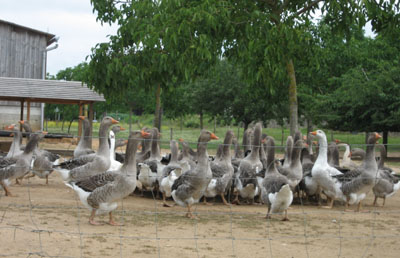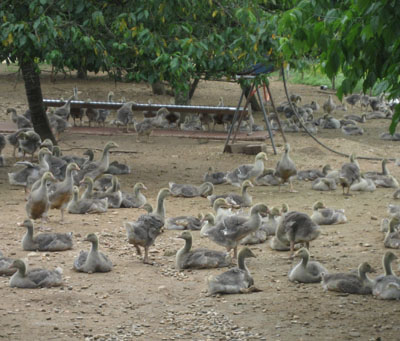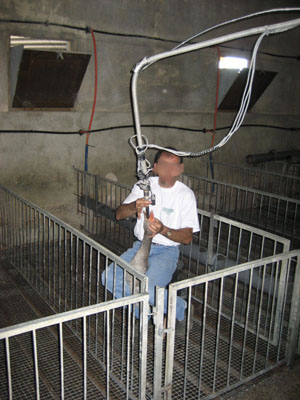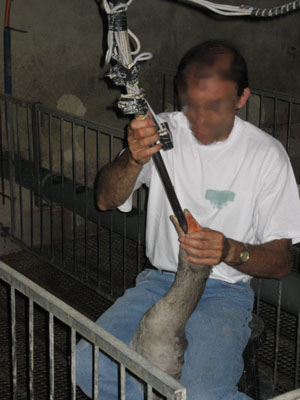Dr Vino's wine blog
wine talk that goes down easy
Foie gras, corks, critters, seasons, Brunello – sipped and spit
 SIPPED: Sauternes
SIPPED: Sauternes
Chicago’s foie gras ban has been repealed in a 37 – 6 vote by the City Council, overturning the 48 – 1 vote that put the ban into effect two years ago. The prices of Sauternes, the unctuous sweet wine often served as an accompaniment, just went up an additional ten percent. [Sun Times, thanks Stephen!]
SIPPED: Cork back for an encork
When a member of the Culinary Institute of American saw my cork iPhone case in February, she exclaimed that it would be the perfect product for recycling their corks! But apparently someone had other plans as the 900 corks pulled there a day will now be recycled in a new program called ReCORK America, sponsored by a cork producer to underscore the “natural” qualities of cork. But what is the carbon footprint of sending all that cork into be recycled into floor tile (and sidebars for wine blogs). Wouldn’t the CIA be better reusing them as festive holiday wreaths–or those iPhone covers?!?
SPIT: Critter labels
On the heels of our worst wine label contest comes more advice, this time from Wines & Vines. One item: a label designer Down Under has a “no critters” policy after seeing the kangaroo reinvented some “50,000 times.” [Wines & Vines] Related: ”
SPIT: Brunello di Montalcino
Not content with the FAA’s Global War On Toiletries, US federal authorities are now turning their eyes on another liquid: Brunello di Montalcino! A recent scandal has revealed blending of grapes other than sangiovese, the only one permissible under the local DOC rules in the wine. Now, as a result, the feds are threatening to block US imports of the pricey Italian wine as of June 9. “Part of our mandate is to make sure all labels are truthful, accurate and not misleading to the American consumer,’’ Mr. Resnick of the US Alcohol and Tobacco Tax and Trade Bureau told Eric Asimov. Um, OK, how about starting with Korbel “California Champagne”? [NYT]
 SPIT: asparagus in December
SPIT: asparagus in December
In a piece that, oddly, has not received much attention here in the US of A, celebrity chef Gordon Ramsay–known for his high-end restaurants in several countries as well as cursing like, well, a chef–lays into out-of season like nobody’s bidness calling for it to be outlawed in the UK. While absolutely laudable in principal, the legislative angle may be the wrong way to achieve this policy goal. And let’s hope eating local in his case doesn’t mean eating any more horse! [BBC]
SIPPED: Wine into water
Wine & Spirits magazine will be holding two public tastings in Los Angeles and Seattle that sound like fun with good people and good wines. Since I gave up bottled water for thirty days and lived to tell the tale, I like the secondary cause too: $5 of each ticket will go to local water conservation organizations. [Wine & Spirits Hotpicks]
(image 1)
No merlot, talking urinals, splurge, what’s hot – tasting sized pours
No F&*%# Merlot!
Miles may have had a rant against merlot in Sideways, but now officials in Utah are piling on the grape–and wine itself. The officials have revoked a personalized license plate in use for ten years with the word “MERLOT” on it citing a state ban on words of intoxicants to be used on vanity plates. Wow. The owner should file for “VINO,” which should give him another 10 years. [AP]
Binge 1
Taking their campaign against DWI to a new, um, level, New Mexico has introduced the talking urinal cake. A woman’s sultry voice intones, “Hey there, big guy. Having a few drinks?” and then advises a taxi. A laudable goal for sure, but what’s up with the sultry voice? Don’t want guys to lean on the urinal and ask it out on a date! [Free New Mexican, with video!]
Binge 2
One Chinese traveler blew $30,000 in a 15-minute shopping spree at a duty free shop in Charles De Gaulle airport. His haul included a 200 year old cognac, a 100 year old armagnac, and a 45 Mouton–but if he’d only shopped around, he could have found it for half the price! [news.com.au, thanks U:TB!]
What’s hot?
Everything. Grape varieties across the board from riesling to pinot gris/grigio were up; only lowly white zin (not even a grape, but a style that’s out of style) was down according to Nielsen scanner data for 2006. Screwcaps gained acceptance and New Zealand zipped higher. More details at Uncorked.
Cheap wine, it’s fine
The Gray Lady has run tests to determine what I have practiced for a long time out of my sheer miserly tendency: using cheap wine is fine for cooking. [NYT]
Puck says no duck
A three-year campaign against Wolfgang Puck has brought the chef to his knees–he’ll stop serving foie gras in his restaurants. [AP]
Varietal, crushed
Frank Bruni one-stars the wine-themed restaurant Varietal. He can’t seem to stop giggling about the “grower champagnes,” which reinforces my thinking that they should be called indie champagne. He also trashes the desserts, which “don’t so much eschew convention as pummel and shatter it — literally, and often pointlessly.” I found the same with molecular gastronomy desserts in my experience at Moto. [NYT]
Tasting sized pours – extreme food and wine edition
“You’re Mispronouncing ‘Achatz'” A primer on molecular gastronomy. Tip #2: don’t call it molecular gastronomy [Chow]
“I ate bird stomach, lamb’s brain, hearts, thymus gland, intestine, and the livers of veal, chicken and goose in the past 14 days. What an offal fortnight.” offal puns more like it. Staff writer Ryan Sutton reviews Momofuku Ssam and Ariyoshi . [Bloomberg]
“And if states like California can ban foie gras, I guarantee you that veal, lobster and cattle will be next, and in 50 years we will all be forced to be vegetarians.” said Ariane Daguin, owner of D’Artagnan gourmet foods. Um, I doubt it. [Bloomberg]
“Vintners have been using byproducts from milk, eggs, wheat and even fish guts in the winemaking processes for centuries. But a new federal proposal could require American wineries to disclose such unsavory items – used as “fining” agents to remove grit – as ingredients.” Fine wine, indeed! Just don’t tell the vegans about the bull’s blood. Just kidding!!! [AP]
Related: “Cantu feel the love tonight”
Foie gras fest 2006 continues!
Michael J. Panter, New Jersey Assemblyman has proposed a statewide ban on the forcible feeding of ducks and geese to make foie gras. Hmm, but non-forcible foie gras would be OK?
The ban set Anthony Bourdain on one of his “bobble-head doll rants”–or so Michael Ruhlman asked the opinionated chef/author in an enteratining exchange on Salon.com.
And just in case you don’t like chewing your foie gras, you can now toss down the hatch and try not to trigger your gag reflex. According to NYMag, the newly opened Lonesome Dove Western Bistro has this on their menu:
FOIE GRAS SHOOTER: Liquefied foie gras, something I created a couple of years ago. I roast the foie gras with some chiles and some salt and then we take all that fat and emulsify it with orange juice, Grand Marnier, and fresh coffee grounds. Put it into a shot, top with whipped cream, and make a little tuile cookie with foie gras instead of butter. In the cowboy spirit, do it in a shot and eat the cookie. Gorgeous!
Related:
“Goose gitmo” [Dr. V]
“Foie gras, arrest thy neighbor” [Dr. V]
 tags: sauternes | foie gras | food and drink
tags: sauternes | foie gras | food and drink
Tasting sized pours — foreign bodies
Holy goose: A Chicago Rabbi invokes the wrath of God if the City Council’s two Jewish members vote to overturn the ban. The measure was passed 48-1 earlier this year. [Sun-Times] Related: Goose gitmo
French women do get fat: A study finds that a third of French woman are overweight. Is it the foie gras? Or fast food? [Daily Mail]
British wine writer Hugh Johnson is against “bodybuilder” wines calling them “boring, without any useful purpose.” They remind him of “steroid-packed bodybuilders, merely made to win competitions.” But what would the Governator say? [Sunday Times]
Getting bigger: the AOC Coteaux de Languedoc also had its boundaries extended taking it a step closer to a regional appellation. But with a new regional AOC Languedoc due to be approved in a few weeks, one wonders why the duplication? [vitisphere]
Four more: The national committee of INAO, the French appellation regulatory body, has granted four more AOCs in the Loire. Enough already with the far-flung regions! How about adding varietal labeling too?
Tasting sized pours
Foster’s, the Australian brewing co that swallowed Southcorp wine for A$3.2 billion last year, announced quarterly results. Beer bolstered sagging wine and management can’t think of anything better to do with their cash than buy back A$200 mln worth of its own shares. Now there are rumors that the “world’s top two” are eyeing Foster’s–the big two brewers that is, InBev and SABMiller. Hmm, what would happen to the wine assets? More turbulence could be expected. [Sydney Morning Herald]
Also down under, but riding the wave better than their neighbor, New Zealand wine exports rose to record levels in June. We recently learned about Australian researchers using worms, this week kiwi researchers are studying how to keep that “cat’s pee” smell in their sauvignon blanc. [NZ Herald]
As Labor Day approaches, many California wineries may have trouble finding labor for harvest. [SLO]
With new tax deductions for conservation easements, will vineyard owners swear that it will be forever condo-free? One already said yes. [WBM, SPD]
Michael Mondavi finds he can’t use his own name for his new wine venture. [ModBee] A sign of the times: this is becoming so frequent that Eponymous is already taken.
Want a snack? How about a foie gras Pop-Tart? No, it’s not available at your local supermarket aisle–it’s only available at the bar at the Four Seasons in NYC. “The process was to come up with a finger-friendly way to eat foie gras,” chef Brooke Vosika told Time Out New York. Foie gras baked in piecrust and served with port wine jelly $28. Sauternes extra.
Foie gras, arrest thy neighbor
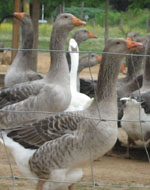 Chicago’s ban on foie gras sales in stores and restaurants went into effect yesterday. On Monday, 676 Restaurant and Bar at the Omni Chicago had an “outlaw dinner,” which included foie gras along with absinthe and hemp seeds, and duck breast sous-vide, a preparation that is currently experiencing a moratorium in NYC. Apparently at least one restaurant in bordering Oak Park is offering a foie gras getaway dinner.
Chicago’s ban on foie gras sales in stores and restaurants went into effect yesterday. On Monday, 676 Restaurant and Bar at the Omni Chicago had an “outlaw dinner,” which included foie gras along with absinthe and hemp seeds, and duck breast sous-vide, a preparation that is currently experiencing a moratorium in NYC. Apparently at least one restaurant in bordering Oak Park is offering a foie gras getaway dinner.
But is the ban really going into effect? Three items for your consideration:
1) Allen Sternweiler of Allen’s The New American Café will file suit against the ban.
2) Didier Durand of Cyrano’s will practice civil disobedience by giving away the foie gras for free and then charging for the garnishes and wine that go with it.
3) The enforcement mechanism of the ban is citizen’s arrest!! “Alderman Moore says the mayor’s office will decide how this law is ultimately enforced, and they will likely rely on citizen complaints.” [CBS2chicago]
Related:
I suppressed my gag reflex and visited a foie gras goose farm
Goose gitmo
[Caution: potentially disturbing photos follow the text]
Foie gras has emerged as a searing flashpoint in America where the Chicago city council has banned it and the California legislature has told the two resident producers to leave the state. Their logic is one of animal rights: cruelty to geese and ducks through force feeding that enlarges their livers to ten times the normal size.
I had abundant opportunity to sample foie gras while I was in the Dordogne region of France last month. But beyond simply eating it, I could see how it is made since it is one of the main agricultural products of the region. The characteristic low-slung, windowless barns that are the sites of the force feeding punctuate the rural landscape.
An American might suspect the barns to be underground bunkers or out of view as a refuge against rampaging hordes of activists from the animal rights group PETA. In fact, many producers hang signs to encourage visits, motivated in part by the high profit margin of selling directly to the consumer. I stopped by one producer who had a small sign in the window to his sales room: gavage 11:00 AM and 6:00PM.
Gavage is the process of force feeding the geese during the last month of their lives. I was intrigued that the producer would invite us into this goose gitmo. Did I have the stomach to see such a controversial practice in action? The rest of my family opted for a swim. I returned to the farm at 6 PM.
The geese were distributed in two large, open fields. The fluffy young ones were on one side. At about eight weeks old, they are moved to the other field for the final month before heading to the gavage barn. These were Toulouse geese, gray in color with darker plumage in the wings, a white undercarriage, and an orange bill and orange feet. The older ones already had a formidable waddle in the low-hanging bellies that almost touched the ground.
The several hundred geese in both areas had abundant food and water and could eat at will. They were outside and could roam freely. Their heads were bobbing up and down out of the water trough on the hot day. And they were loud. I hadn’t heard this much honking since I left Manhattan.
Two French couples (and a pet dog) had turned up as well and at about 6:20 the farmer arrived to lead us around. He was very open in describing the process and answering questions. One of the others in the group asked about American protests and the farmer said that he didn’t really care since none of his sales went to America. All of his sales were direct from of his shop adjacent to the large goose pastures.
Further, he said that French media coverage of American boycotts and bans devastating the industry was overblown since only four percent of French foie gras was exported to the US. Unlike cognac, which the French make for the rest of the world with 95 percent of production exported, the French tend to make foie gras for themselves, making 70 percent of the world’s production and eating 85 percent of it (Hungary helps fill the gap). According to a well-written story by Mike Steinberger in the Financial Times, the French National Assembly declared foie gras “a cultural and gastronomic patrimony protected in France” last October.
The farmer then picked a goose by the wings and we then moved into the gavage barn, which was mercifully empty and surprisingly dark. Although there were still geese on the farm, the farmer didn’t do gavage during July and August to take a vacation for himself and the staff.
After three months in the open, the geese are escorted to the gavage barn and put twelve per pen. He explained that they are gregarious and that’s why they are kept together. They are then force-fed four times a day with a machine operated by a person in the pen with the geese. The food is corn, starchy, empty calories good for fattening he said. This stands in contrast to the balanced diet that the geese received while they were outside.
The farmer said that the geese do not have the ability to swallow, which explains why their heads bobbed at the water trough outside: they filled their mouth and gravity took the water down. Nor do they have a gag reflex, which is apparently linked of the ability to swallow. No peristalsis, no reverse peristalsis. He said that conditions were worse for ducks (whose livers are also valued and he does not have) since they are smaller and have less of a group mentality they are force fed mechanically and kept in smaller pens with more per shed.
Whether or not having a feed tube shoved down the throat causes pain to the birds, the fact that they are kept in the dark for this last month of their lives, fed four times a day and rapidly put on weight cannot be pleasant. In the end they are slaughtered and a new group is brought in.
What’s interesting from a socio-economic point of view is that the nature of the French farm is changing. The farmer told us that a generation or two ago, a farmer would have a limited number of diverse livestock and would force-feed a goose in time for Christmas. But now there is increased specialization among farmers. He started only a decade ago. His neighbors around him grow only corn.
Back in America, what’s motivating the foie gras protesters and the legislators? Is foie gras production really any different than the inhumane conditions that exist for veal? Or other livestock from poultry to hogs to cattle? (As vividly shown in Michael Pollan’s The Omnivore’s Dilemma or Eric Schlosser’s Fast Food Nation among other places) Will osso buco be coming into the sights of legislators?
Probably not. The trouble with arguments that suggest foie gras is the thin edge of the wedge is that it is just so thin–the amount of foie gras consumed in America is miniscule. And that’s a part of what appeals to activists and legislators alike: it’s easier to take on the three American producers of foie gras than it is the National Cattlemen’s Beef Association.
But it is instructive—nay, essential—to know where food comes from. That’s why I signed up for the gavage tour. Meat, while it’s alive is a lot different from meat in a confit jar or under plastic wrap in the supermarket. If everyone were more aware, more people might choose to be vegetarians. Or not. After all, Michael Pollan still eats meat and Eric Schlosser still eats hamburgers. But it would be an informed choice.
